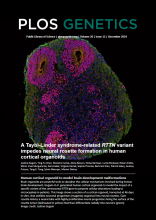
Identifying the unique case of a patient presenting the clinical traits of Taybi-Linder syndrome (microcephaly, growth retardation, cortical malformations, facial dysmorphism), usually associated with variants in the RNU4ATAC gene, the team aimed at understanding the pathophysiological mechanisms leading to microcephaly in this patient carrying a variant in RTTN. To this end, it has developed unique models of neuronal progenitors and cortical organoids derived from CRISPR/Cas9-edited iPSCs. It has shown that a series of cellular alterations (defects in mitosis, mitotic orientation, ciliary function and organization of progenitors into neural rosettes) are probably at the origin of microcephaly. These are all clues to now understand the mechanisms associated with RNU4ATAC loss of function!











